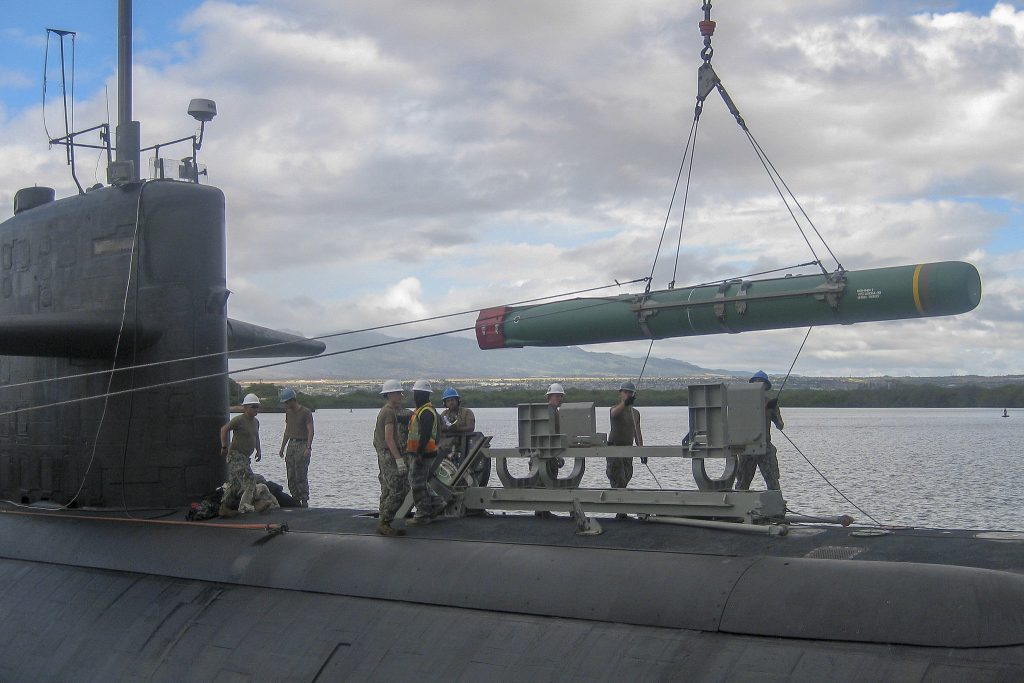
Sailors load a Harpoon anti-ship missile aboard the USS Olympia.
WASHINGTON: After a 25-year absence, the Navy will start packing Harpoon ship-killer missiles on its attack submarines as the fleet looks for new ways to counter the growing Chinese navy.
The effort falls in line with a range of programs the Pentagon is pursuing to develop ways to deploy more offensive punch at longer ranges, a clear recognition of the growing ability of China and Russia to keep American and allied forces at a distance in any potential confrontation.
The Harpoon work was capped off late last month when the Navy awarded Boeing a $10 million contract to arm Los Angeles-class attack subs with the new Harpoons as soon as this year. The contract follows the successful test firing of a Harpoon from the USS Olympia submarine during the RIMPAC 2018 exercise off the coast of Hawaii, marking the first time the missile had been fired from an American sub since 1997.
The Pentagon has been working on getting its ship-killing prowess back since the Obama administration, when then-Defense Secretary Ash Carter launched the Third Offset Strategy aimed at developing new technologies, and repurposing old ones, to make the force more lethal, at moderate cost — and to do it quickly.
The increased missile range also fits with the emerging Navy strategy which accepts the risk posed by precision weapons and stand-off capabilty developed by China, in particular. A “tri-service” strategy released by the Navy, Marines and Coast Guard in December pointed out the plan is to continue to develop “ready, forward-deployed naval forces [which] will accept calculated tactical risks and adopt a more assertive posture in our day-to-day operations.”
The work began to pay off in the fielding of the over-the-horizon Naval Strike Missile, made by a team made up of Raytheon and Norway-based Kongsberg. The weapon, with a range of about 100 miles (roughly comparable to the Harpoon), has been deployed aboard the Littoral Combat Ship USS Gabrielle Giffords, and will become a mainstay aboard the Constellation-class frigates which begin construction this year.
The entire fleet of more than 30 Littoral Combat Ships will eventually be equipped with the NSM, Navy CNO Adm. Mike Gilday told Breaking Defense recently.
“In today’s in today’s competitive space with China, in particular, you need lethal systems like the Naval Strike Missile on every single and every single LCS that we have. And so in order to and so, I do want those ships deployed in numbers,” Gilday said.
The Navy and Marine Corps are also looking for ways to get the NSM fitted aboard its amphibious ships, a move that advances the emerging plan to find ways to add more punch to the US fleet as China and Russia push their own long-range weapons out to sea.
“We have these magnificent 600-foot-long, highly survivable, highly LPD 17s,” Marine Maj. Gen. Tracy King, the Navy’s director of expeditionary warfare, told reporters last month. “The LPDs need the ability to reach out and defend themselves and sink another ship. It’s not from the aspect of using them as a strike platform; it will drastically increase their survivability if the enemy has to honor that threat.”
Putting those missiles aboard large, amphibious ships also wielding F-35Bs is in line with the Corps’ efforts to find a way to fire long-range anti-ship missiles from shore-based ground vehicles to support the fleet from dispersed locations. Last year, Raytheon was awarded $48 million to integrate the NSM into the Marine Corps’ force structure, following a year-long study the Corps conducted, where it also considered Lockheed Martin’s new Long-Range Anti-Ship Missile and the Harpoon.
In December, the Navy also fired a new version of the Cold War stalwart Tomahawk missile from the destroyer USS Chafee, giving the surface fleet an expanded ability to target ships and land targets at greater range. The Black V Tomahawk is expected to reach ranges in excess of 1,000 miles with a new warhead that will carry a bigger punch than older versions.
Navy jet trainer fleet operations remain paused after engine mishap
One week after the incident, a Navy spokesperson says the service is continuing to assess the fleet’s ability to safely resume flight.


























